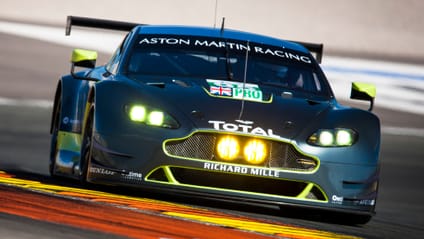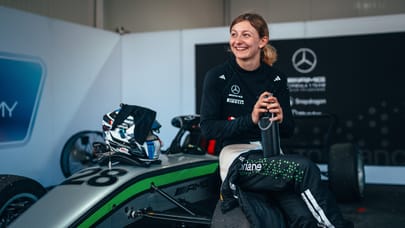
What's it like to drive an Aston Martin GTE racer?
Get behind the wheel of a GTE Pro car. AM's Darren Turner is your guide


In just over a month’s time, the new season of the World Endurance Championship gets underway with the Six Hours of Silverstone: the first of nine rounds on the calendar for 2016.
With regulations designed to produce close racing, the series continues to deliver action and excitement at a time when Formula One – supposedly the pinnacle of motorsport – is suffering as a spectacle.
While only four drivers have taken the chequered flag in F1 since the start of 2014, few people could confidently pick out winners from any of the four WEC categories for the forthcoming season. The GTE Pro class looks especially tight, with a Porsche-supported programme up against Ferrari, Aston Martin and new entrants Ford.
As well as being exhilarating, GTE racing also benefits from greater everyday relevance than the prototype section, owing to the FIA’s strict rules on cars being based on production models that can be bought by (admittedly very fortunate) members of the public.
But, as is the case with all premier forms of motorsport, the vast majority of fans will still never be able to truly appreciate what the very cars they are cheering on from the stands are really like to drive.
So, what's the closest you could get to sitting behind the wheel without physically being in the driving seat?
Enter Darren Turner, seven-time class podium finisher at the 24 Hours of Le Mans and works driver at Aston Martin Racing for more than a decade.
The 41-year-old will have a naturally aspirated 4.5-litre V8 and a rear wing measuring 1,800mm at his disposal when he lines up on the grid at Silverstone in April; a combination of parts capable of making even the most highly tuned performance car seem lethargic in comparison.
Add slick tyres, instant power and featherweight lightness into the mix, and you have a driving experience beyond most people’s comprehension.
In Turner’s own words, here’s what it feels like when all of those elements come together...
Advertisement - Page continues belowDarren Turner on... the seating position

“You’re in the car for what could be up to four hours, so you have to be comfortable. So we always have moulded seats. Obviously my two teammates [Nicki Thiim and Marco Sørensen] this year are big chaps compared to me; both over 6ft. So Nicki has made the base seat, and then I make an insert that will go into his seat so that when we do the driver change, I just put my insert in. It’s moulded around me, and it should give me all the support.
“You’re looking for the support on the core of your body just so all the G-forces are being picked up by that, rather than you having to hang on to the steering wheel.
“We call it the booster seat, the child seat, baby seat... Effectively it is a baby seat really. So that goes in the car, then you’ve got a five-point harness plus your HANS device, so you’re very enveloped inside that little cocoon of the seat as well.
“And it’s a nice feeling. You do feel very safe inside these cars. We’ve been running the side-nets around the seat for a good two or three years now, so again you lose a bit of visibility but you’re even more enclosed inside the car.”
Darren Turner on... the pedal box

“The pedal box is raised off the ground, so generally your backside isn’t much higher than your feet. There’s probably only 30mm difference. So it’s quite a flat seating position. It’s not like F1 where the bums are lower than the feet, but it’s certainly a lot flatter than a normal road car.
“The pedal box itself is still three pedals. The clutch you only ever use when you pull away and when you come to a grinding halt. That’s it. And it’s set up for both right foot and left foot brakers as well. Both Nicki and Marco are left foot brakers and I stay with a right foot brake...”
Advertisement - Page continues belowDarren Turner on... the brakes

“I think the element that is most surprising for people that have never sat in a race car is how hard the brake pedal is. It’s not servo assisted, and we can be putting up to 100psi into the system two or three times a lap. And the movement in the pedal is minimal: 5mm, and a long pedal is 10mm. Because it’s not servo assisted you’ve got to generate all the pressure. So the pedal itself doesn’t move much.
“It’s interesting because obviously you’re braking very hard from high speed most of the time, and you’ve got to have consistency. When you’ve got brakes that aren’t consistent, it makes doing a race-long stint quite entertaining. At that point all you’re worrying about is tuning the brake bias from either the front to the rear to make the most of the grip that you’ve got available if it’s on the front axle or the rear axle.”
Darren Turner on... the throttle

“When you come off the brakes and apply the throttle, it’s instant. There’s hardly any flywheel to the engine, there’s low momentum in there so it responds very quickly.
“The throttle pedal normally has about 70mm of throw at the top with quite a strong return spring, just to stop any kind of oscillation when you come off the throttle. And effectively you’re just operating those two when you get going off the pit lane.”
Darren Turner on... the steering wheel

“We’ve got a new steering wheel this year because we’ve been allowed to remove top and bottom: that gives us more vision of the dash. Just as most race cars are going, where you hold your hands is your steering wheel. You’re just holding onto the grips, and it’s a really nice feeling.
“There’s never any feed in the wheel so your hands are just there, and they’re stuck there and that’s the position you need to be. And you want everything to be very close and easy to get to with the buttons and the rotary switches and bits and bobs.”
Darren Turner on... the dashboard

“I think currently we’ve got twelve buttons and five rotary switches on the steering wheel, and we have to know exactly what they are with your eyes shut. Because if things are going wrong when you’re out on the track, or if you’re in a massive pressure situation, you can’t be looking away to try and find the switch to activate it. You need to know exactly where it is and still be able to keep your eyes on the road.
“We’ve got a new dashboard this year. The dash we had before probably did four or five seasons with that configuration... we’ve now moved on to the latest Cosworth dash. It’s much clearer, we can change it to suit the drivers. You can pretty much choose what you have on display, and on the steering wheel you have a page button so you can have many pages, and you just scroll through to get the information you want. Generally there’s one page that gives us all the information that we need to drive fast.”
Advertisement - Page continues belowDarren Turner on... mechanical grip

“If you bolted a set of slicks onto a standard road car, I think most people would then be amazed at the performance of their road car. That’s the jump a slick tyre makes compared to a normal road tyre. They’re not designed to do 30,000km like a road tyre, so they’re very aggressive in the way that they work and how they produce the grip.
“It’s a huge difference. I really think most of the jump between road and race is made with that tyre, and then the refinement of losing weight, aero, more power, all that responsiveness. But probably one of the biggest individual things in performance is a slick tyre.”
Darren Turner on... aerodynamic grip

“It’s funny because people think it’s a switch, and it’s not. It’s there from 20mph. You don’t feel it, but at 20mph if you put your hand out of the window, your hand will move. And at 100mph it nearly gets ripped off your body, doesn’t it? So even in the low speed corners where it’s 60mph or something, aero is working.
“We’ve all been on a journey from driving karts which have no aero, to lower formulas which have got a little bit of aero, and we’ve moved up to the single seaters or whatever our journey has been to be in this position. I guess you get to understand what the aerodynamics are doing, but in a gradual learning curve.”
Advertisement - Page continues belowDarren Turner on... the noise

“We have moulded earpieces with the radio in them, then you’ve got your balaclava, then your helmet. And the helmet is quite a tight fit: the key is to be able to hear your engineer on the radio.
“The noise is loud, and it’s constant as well. So quite often you’ll get out of the car after a long period in it, and your ears will be ringing. And that’s fairly normal for any normally aspirated V8, because there’s no real silencing going on, there’s no soundproofing within the car. So it’s raw, and you’ve got the protection of your earplugs, balaclava and helmet, but you’re wrapped in that noise. So it’s a noisy environment to be in.
“But I love it. It’s a nice place to be. Silence is sometimes nice but I’d rather have a booming V8 or a V12 in front of me than a quiet room or something.”
Trending this week
- Car Review
BMW 1 Series
- Top Gear's Top 9
Nine dreadful bits of 'homeware' made by carmakers







